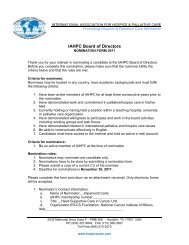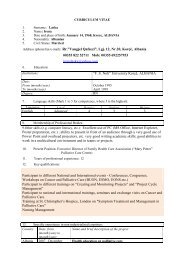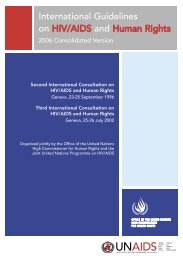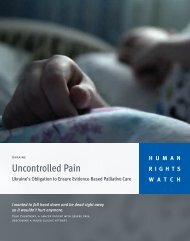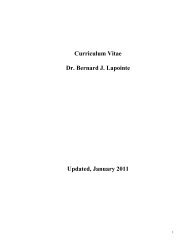INTERIGHTS Bulletin
INTERIGHTS Bulletin
INTERIGHTS Bulletin
You also want an ePaper? Increase the reach of your titles
YUMPU automatically turns print PDFs into web optimized ePapers that Google loves.
164<br />
<strong>INTERIGHTS</strong> <strong>Bulletin</strong><br />
Volume 16 Number 4 2011<br />
intersex conditions or atypical sex<br />
organs (also called disorders of sex<br />
development) routinely face abuse<br />
amounting to ill-treatment in health<br />
settings. 48 These include a variety of<br />
forced, unnecessary and irreversible<br />
medical procedures such as<br />
sterilisation, hormone therapy and<br />
genital-normalising surgeries such as<br />
clitoral ‘reduction,’ 49 considered<br />
genital mutilation by some intersex<br />
people. 50 These procedures are rarely<br />
medically necessary, but are performed<br />
for social reasons and can cause<br />
scarring, loss of sexual sensation, pain,<br />
incontinence and lifelong<br />
depression. 51 They are typically<br />
performed without any legal restriction<br />
or oversight in an attempt to impose a<br />
biological gender of either male or<br />
female. 52 Parents are frequently<br />
pressured to consent to these<br />
procedures for their children without<br />
adequate information about the longterm<br />
risk to sexual function and<br />
mental health. 53 Intersex children are<br />
also often exposed to humiliating and<br />
unnecessary exams 54 or are used as<br />
teaching tools or in unethical medical<br />
experiments. 55 In 2008, a German<br />
intersex woman, Christine Völling,<br />
successfully sued her surgeon for<br />
damages for removing her ovaries and<br />
uterus without her informed<br />
consent. 56<br />
Roma in Central and Eastern Europe<br />
face what the European Roma Rights<br />
Center (ERRC) has called ‘a consistent<br />
pattern of discriminatory treatment’ by<br />
medical professionals. 57 Such<br />
discrimination may rise to the level of<br />
cruel, inhuman or degrading<br />
treatment, as when health workers<br />
insult Roma patients and their<br />
families. In one case documented by<br />
the ERRC, a woman whose son had<br />
died after being released from the<br />
hospital, reportedly in good condition,<br />
said that in response to her demands to<br />
see her son’s medical file a doctor said<br />
of her son’s death, ‘It’s not a big<br />
thing—one Gypsy less.’ Denial of<br />
medical care to Roma has taken the<br />
form of failure of ambulances to<br />
respond to requests for assistance<br />
coming from Roma neighbourhoods,<br />
outright refusals by medical<br />
professionals to provide services to<br />
Roma and demands for payment for<br />
services that ought to be provided at no<br />
cost. In one case, a 20-year-old Roma<br />
woman gave birth to a stillborn child<br />
after an ambulance took 90 minutes to<br />
arrive at her home in a Roma<br />
settlement; one dispatcher mockingly<br />
told the woman’s husband ‘to put his<br />
wife into a wheel-barrow and wheel her<br />
to the medical center.’ In another case,<br />
a woman was inappropriately charged<br />
for medical treatment for a<br />
spontaneous miscarriage, apparently<br />
because doctors assume that Roma<br />
women induce their own abortions to<br />
avoid paying the cost of surgical<br />
abortions. A particularly humiliating<br />
practice is the segregation of Roma<br />
patients into rooms called ‘gypsy<br />
rooms’ or the ‘Chinese quarter.’<br />
According to the ERRC, these Roma<br />
wards are of inferior quality ‘in<br />
material and sanitary conditions and<br />
services.’ It has also been reported that<br />
Roma women accompanying their sick<br />
children are made to clean the ward.<br />
Conclusion: The Need for Monitoring<br />
and Accountability<br />
The preceding examples of torture and<br />
ill-treatment in health settings likely<br />
represent a small fraction of this global<br />
problem. In order to better understand<br />
and confront this problem, a necessary<br />
first step is for human rights<br />
organisations and official mechanisms<br />
to systematically include health<br />
settings among the places they<br />
document and advocate against torture<br />
and ill-treatment. Courts and tribunals<br />
which are confronted with cases of<br />
severe abuse in health settings should<br />
likewise consider whether these<br />
abuses rise to the level of torture and<br />
ill-treatment. While some have already<br />
done so, this has mostly been in the<br />
case of abuses occurring in prisons<br />
and pretrial detention centres, not<br />
traditional health settings. An<br />
important way to prevent torture and<br />
ill-treatment is to monitor the human<br />
rights of people in the settings where<br />
such practices are likely to take place.<br />
The Optional Protocol to the UN<br />
Convention against Torture (OPCAT)<br />
obliges state parties to establish<br />
independent ‘national preventive<br />
mechanisms’ to carry out preventive<br />
visits to places of detention. For the<br />
reasons set out in this article, health<br />
settings may well be considered places<br />
of detention where people are subject<br />
to torture and ill-treatment. For anyone<br />
with disabilities, states have further<br />
obligations to ‘ensure that all facilities<br />
and programmes designed to serve<br />
persons with disabilities are effectively<br />
monitored by independent<br />
authorities,’ 58 and that the implementation<br />
of human rights is monitored, 59<br />
with the participation of civil society,<br />
particularly people with disabilities<br />
and their representative organisations.<br />
60 The legal implications of a<br />
finding that abuse in health settings<br />
amounts to torture or ill-treatment are<br />
significant. With respect to addressing<br />
acts of cruel, inhuman or degrading<br />
treatment or punishment, the<br />
Convention against Torture requires<br />
governments to provide education and<br />
information to public officials<br />
(including medical personnel),<br />
requires a prompt and impartial<br />
investigation of allegations, and<br />
requires an appropriate complaint<br />
mechanism. 61 With respect to torture,<br />
governments are additionally obliged<br />
to prosecute offences and ensure a civil<br />
legal remedy for compensation of<br />
victims, among other things. Real<br />
accountability for torture and illtreatment<br />
in health settings, however,<br />
means identifying the laws, policies<br />
and practices that lead to abuse, rather<br />
than simply singling out individual<br />
health providers as ‘torturers.’ Health<br />
providers may abuse the rights of<br />
patients because they are ordered to by<br />
authorities, because regulations<br />
restrict the type of care they can<br />
provide or for other reasons beyond<br />
their control. These situations are<br />
sometimes referred to as dual loyalty,<br />
defined as ‘simultaneous obligations,<br />
express or implied, to a patient and a<br />
third party, often the state.’ 62 As part<br />
of their obligation to prevent torture<br />
and ill-treatment in health care,<br />
governments should take concrete<br />
steps to protect health providers from



